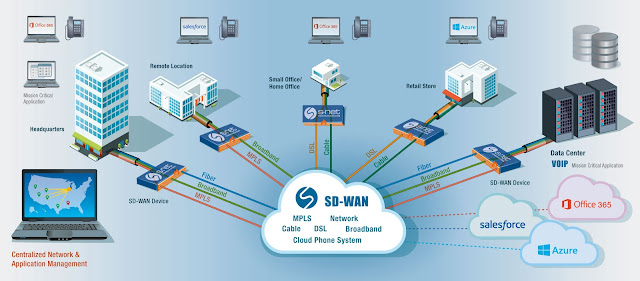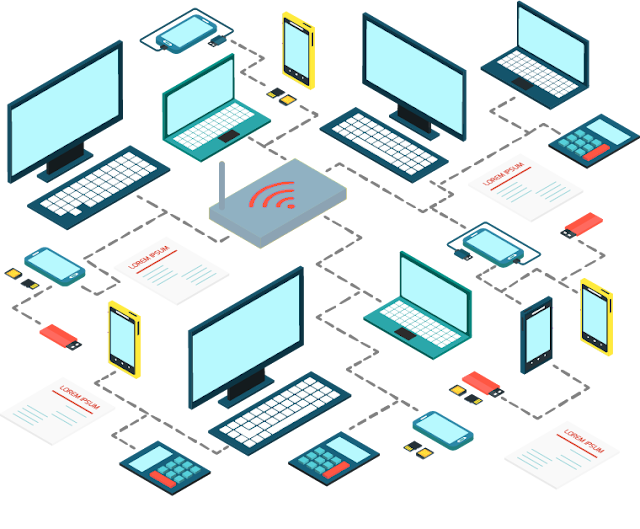What Is A Computer Network..?
A network consists of 2 or a lot of computers that are joined so as to share resources, exchange files, or enable electronic communications. The computers on a network are also joined through cables, phone lines, radio waves, satellites, or infrared beams.
Two quite common varieties of networks include:
- Local Area Network (LAN)
- Wide Area Network (WAN)
Local Area Network :
Wide Area Network :
Wide space Networks (WANs) connect networks in larger geographic areas, like Sunshine State, u. s., or the globe. Dedicated water cabling or satellite uplinks are also accustomed connect this sort of world network. Using a WAN, colleges in Sunshine State will communicate with places like Yedo in a very matter of seconds, while not paying huge phone bills. 2 users a half-world apart with workstations equipped with microphones and webcams would possibly group discussion in real-time. A WAN is difficult. It uses multiplexers, bridges, and routers to attach native and metropolitan networks to international communications networks just like the net. To users, however, a WAN won’t seem to be a lot of totally different than a LAN.What is Computer Networking..?
Computers are the primary tool almost everyone uses every day to share information with one another. These computers come in many different shapes and sizes. They are included in numerous products, including automobiles. When these computers are networked together, we are able to accomplish some amazing things.
Computer networking has allowed us to discover new secrets about the universe. It has allowed us to connect with people all over the world to establish personal relationships. We can find new resources and maximize the effectiveness of our current resources.
Yet there is a dependence factor that must also be considered. If the computer network becomes inoperable for some reason, we lose access to the tools that drive daily life forward all the time. Without computers, many people feel isolated and alone.
When considering the advantages and disadvantages of computer networking, here are the primary key points to think about.
What Are the Advantages of Computer Networking?
1. Computer networks provide personalized experiences.
In the past, computer networks were a generic take-it-or-leave-it system. There was less overall computing power in the space program that landed astronauts on the moon compared to the modern smartphone. We have reached the point in technological evolution where every computer network can be personalized. You can access the information you want or need whenever you wish.
2. Networking increases personal security.
Established computer networks provide a security buffer for sensitive information. This is especially true for networks that are not connected to the internet. A secure network provides information sharing benefits without exposing identifying information to the general public. It is an advantage that allows for fraud reduction while improving productivity practices simultaneously.
3. Computer networks are open to everyone.
If you want to access a computer network, then you have the freedom to do so. The only barrier in place involves owning or having access to a computer to do so. Although not every person on the planet can afford a computer, there are public locations where access is still possible. Even when the information that a network may contain is restricted because of politics, technology access is still possible. Even North Korea offers limited internet experience.
4. It takes minimal computer knowledge to network.
Most computers are based on a WYSIWYG experience – what you see is what you get. If you know how to turn on a computer and can read the instructions that are provided, then you can access all the benefits of the networking experience. For the average person with no experience, it only takes a few minutes to get up and running with the network.
5. Third-party storage enhances the sharing aspect of networks.
One of the biggest problems that have historically plagued computer networks is storage. For the 1980s kids, one of the most common computers in a home during their childhood was the Commodore 64. It had just 64kb RAM and 20kb of ROM. Even computers in the 1990s, such as the Tandy 1000, didn’t feature hard drives because they were so expensive. Today, you can receive 5 GB of free storage from Dropbox, Amazon, and other providers through the cloud. Terabytes of storage are available from third-party providers for minimal fees. The largest PC HDD available on a regular basis offers 16 TB of storage.
6. Technology costs are becoming less of a barrier.
When Steve Jobs unveiled the first Macintosh computer rom Apple on January 24, 1984, it came with a price tag of $2,500. In return, consumers received a 9-inch screen and were required to maintain disk storage independently from the computer. In comparison, the cost of a 21.5-inch iMac with 1 TB of storage, a 2.3GHz processor, and 8GB of memory is priced at $1099. For those with tech skills, a Raspberry Pi can bring you a home computer for about $50. Networking costs are becoming less of a barrier than in the past.
7. Collaboration is possible with computer networks.
One of the biggest advantages of a computer network is that it allows individuals to collaborate on numerous types of projects. Collaboration can be personal, recreational, or professional. Networks allow people to work on the same document simultaneously. Event organizers can network concepts and ideas to start movements that can have political impacts on national and global scales. Families can plan trips or coordinate a shopping list because of computer networks.
8. Information can be shared freely.
In the United States, the average consumer pays about $50 per month to have a broadband connection to the internet. That cost is about $10 more per month than what consumers were paying about 10 years ago. ISP bundles that include television and uncapped access can be as high as $150 per month. Yet, there are also services that provide services for a minimal activation fee and no ongoing fees. FreedomPop provides 500MB of 4G service for free to consumers with a $19.99 activation fee.
9. File sharing in bulk is very easy to do.
In the 1990s, you could share files with other people. All you had to do was bring a bunch of discs with you to the new computer and then wait a few minutes for the files to transfer. Flash drives have replaced floppy discs, but file-sharing has become even easier thanks to the cloud. With a tool like Dropbox, you can upload a file to a public folder and then create a link to it. Share that link to anyone and they can easily access the file at their convenience instantly.
10. It offers people flexible learning and sharing options.
Information sharing through computer networks can take on a number of different approaches. Emails can contain attachments which allow information to be shared person-to-person or to a large group of people simultaneously. Facebook chat allows for files to be uploaded and sent to others as well. Links to specific information are sent to people through social media networks. Files can be synced to multiple authorized devices through the cloud. The modern network is flexible enough that it can support virtually any type of learning or sharing option that works best for each person.
11. Computer networks offer an entrepreneurial option.
According to reporting from Fast Company, up to 60 million people in the United States may be independently employed. That means they would be earning a paycheck as a freelancer, a contractor, or even as a temporary employee. In May 2015, over 15 million people listed themselves as being self-employed. Having access to a computer network allows people to market their skills and talents as a profitable enterprise. This allows people to work for themselves instead of being compensated for helping corporations succeed because of what they can do.
12. They enhance individual productivity levels.
Imagine that you’re on a sales call. Your client asks you a question that you don’t have a definitive answer for. Because of the existence of computer networks, you can immediately locate the information that the client requires without letting go of the conversation. That means there is a better chance to close a deal. The same principle applies to most professions today as well. Computer networks provide an opportunity for genuine multitasking so that individual productivity levels can be enhanced.
13. It allows for anyone to become a global influence.
The phrase, “Be the change you wish to see in the world,” is attributed to Gandhi, but is more of a bumper sticker saying than anything else. Yet, in the era of computer networks, it is possible to be that change. Through a network, there are multiple ways to influence the world in a positive way. People can crowdfund through networks to pay for costly medical bills or unexpected emergencies. Remote villages can receive access to basic necessities. People can share their spiritual experiences. By exposing ourselves to new cultures, we can learn from one another and that really can be a positive force of change in the winds of global influence.
What Are the Disadvantages of Computer Networking?
1. Not everyone has access to computer networks.
Although there are free connection options to modern computer networks, not every person has access to the technology they need. In countries that are called “developing,” fewer than 2 out of every 5 people have regular access to a computer network. Computer networking saturation levels have been increasing. In 2005, just 8% of people in developing countries had access to a computer. Outside of the developed world, however, there are still connectivity challenges that must be met for a truly global network to be created.
2. It can lead to serious mental health concerns.
According to a report from the BBC, gaming addiction is going to be classified as a disorder by the World Health Organization. Networks offer opportunities to share information, but they also offer numerous entertainment options. Gaming can become addictive and lead individuals to serious mental health issues over time. Exposure to electronic screens may also disrupt sleep patterns, trigger insomnia, and lead to physical health issues like obesity as well. Computer networks, like all things, should be enjoyed in moderation to take advantage of the many benefits that are possible.
3. Computer networks are not always secure.
There are numerous ways for a computer network to be disrupted. Hackers can infect computer networks with malicious software and then encrypt the data they contain to hold it for ransom. A simple power outage can make it difficult for individuals to use their computers when they may need information access. Viruses, data corruption, internet outages, and DDoS attacks are all common examples of disruptions that occur every day. Even offline, a computer network is never 100% secure.
4. Computer networks might provide too much information.
The cost of identity theft through computer networks is estimated to be about $100 billion annually from a global perspective. The IP Commission Report offers an estimate of up to $600 billion in losses that occur from the theft of intellectual property. Computer networks provide information access, and this can be a good thing. It can also put too much information into the network, which can be used to harm others, steal funds, and more. Many computer networks are secure, but only because of specific efforts to secure them have taken place. Not every network receives that security.
5. They change our perspectives on relationships.
According to a study reported by the American Psychological Association, nearly half of the workers employed in the United States are active professionally while on vacation. This may include checking emails from work, talking with co-workers about a current project, or even telecommuting from their hotel room. Even when not on vacation, the average person checks their phone around 100 times per day – whether there are notifications present or not. Interacting through a computer network is not the same as interacting with someone face-to-face.
6. There are fewer safeguards in place for computer networks.
The laws which govern our computer networks have not caught up to how they are being used on a regular basis. Tyler Barriss, who lives in California, was charged with a felony false alarm charge for faking a false police report because of an incident that occurred through one of his computer networks. The incident reported a false hostage and domestic shooting and one officer shot a resident, Andrew Finch, because of the information shared. Finch lived in Wichita, Kansas. Computer networks offer many conveniences, but without the same security that governs society outside of the network.
7. Computer networks create recall dependence.
It is not just addiction that people need to be worried about with computer networks. The amount of information that we have access to each day may become the primary source of memory for some individuals. A study reported on by The Daily Mail in 2012 from Harvard, the University of Wisconsin, and Columbia University reported that people in research groups would actively not make an effort to remember something if they knew they could look it up through a search engine.
8. Computer networks rely upon a high-quality installation process.
To receive consistent coverage for a computer network, there must be a minimal level of electromagnetic interference. Buildings with multiple wireless networks can often cause interference, which disrupts user access to the information that they may require. Certain buildings, such as those which use steel reinforcements, can make it difficult for computers to pick up the necessary frequencies for data sharing. For a network to operate efficiently, great care must be taken during the installation process to eliminate interference issues.
9. They can cause more downtime than productive time.
Multitasking might be possible with computer networks, but not everyone is an efficient multitasker. According to Wrike, task switching can cause a 40% loss of productivity. The amount of information that individuals can process is finite. Just 2% of people are able to handle multiple intensive tasks simultaneously without losing productivity levels. For everyone else, there must be a conscious effort to take on one task at a time to take advantage of what computer networks provide.
These advantages and disadvantages of computer networking offer humanity the tools that will be required for future growth. There are always new risks, security concerns, and unforeseen problems that come with such growth. By learning from the various negatives we have seen in past steps of growth, we can be ready for a future where everyone can be connected through computers if that is what they wish to do.















0 Comments